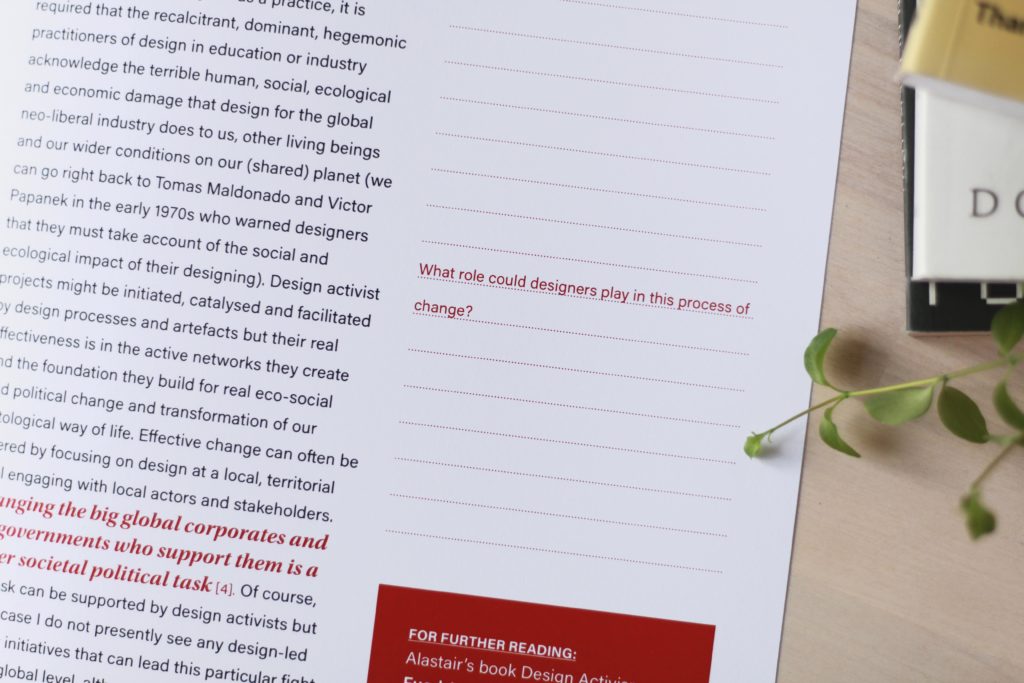Design Activism and the Fight for New Pluralities Through/Within Design
Based on a digital conversation with Alastair Fuad-Luke that took place in April 2020
Edited by Maaike van Papeveld
Photo courtesy of: Joana Machado, copyright Alastair Fuad-Luke (portrait Alastair Fuad-Luke)
.
My “working definition” of design activism in my book Design Activism: Beautiful strangeness for a sustainable world (2009, Earthscan, London, p27) was:
Design activism is ‘design thinking, imagination and practice applied knowingly or unknowingly to create a counter-narrative aimed at generating and balancing positive social, institutional, environmental and/or economic change’.
I also differentiated between activism supported by design and activism led by design (design-led activism). My book addressed design-led activism. In 2015 I compared design activism with design for social innovation/social design. While I found common ground between these two design approaches, design activism is framed by participatory democracy, agonistic pluralism, interests of diverse communities, utopian logic, change of habitus, radical innovation and motivational framing that all contest structural coupling, co-dependent affinities and locked-in meaning and constituted relationships i.e. design activism strongly contests the status quo to seek alternatives and does so through independent action and collaboration.
.
It is important that the design activist is an independent free agent who can choose who s/he works with to address the issue and achieve genuine individual and societal change or transformation. Generally, design activism is project-orientated around specific issues so the actors and stakeholders that are engaged by the design activist tend to have an inherent interest in the issues and the contextual situation. In my opinion design activist projects tend to generate specific situated knowledge, and therefore evolve practices that are situated. Some of these practices may be transferable to other contexts, some may be unique to the project, its location and the actors/stakeholders.
.
‘A central tenet of design activism is that it simultaneously addresses societal issues of concern while changing the essence of what it means to design’ (Fuad-Luke, 2015, p294). Design activism is active on two fronts—the identified issue and on the theoria, praxis and poiesis of design itself. As a consequence design activism often encounters resistance and opposition from within the professions of design education and design industry who wish to protect/preserve the current normalised way of designing. Design activism contests who designs and who participates in the designing, so, I guess the resistance is expected.
.
After over twelve years of debate and practice in academia and the wider design world I would like the work and endeavours of those who call themselves design activists to be recognised and embraced by all the conventional disciplines of design. Perhaps this could simply mean that all design educationalists and professional designers re-examine the ethical and practical codes by which they work and refuse to work for companies, government or other institutions that do not care for the human, social and ecological consequences of their deeds. However, past design history makes me sceptical about this change and post Covid-19 design educationalists and practitioners will not doubt be desperate for (any) work. So, I would like to dream that a design-led activist project captures global attention and, consequently, becomes an attractive disciplinary approach to existing and future designers.
.
At this moment, design activism is thus still very much a minor activity in the domain of design which is generally enacted to promote the global neo-liberal capitalist mode of producing and consuming. For design activism to grow as a practice, it is required that the recalcitrant, dominant, hegemonic practitioners of design in education or industry acknowledge the terrible human, social, ecological and economic damage that design for the global neo-liberal industry does to us, other living beings and our wider conditions on our (shared) planet (we can go right back to Tomas Maldonado and Victor Papanek in the early 1970s who warned designers that they must take account of the social and ecological impact of their designing). Design activist projects might be initiated, catalysed and facilitated by design processes and artefacts but their real effectiveness is in the active networks they create and the foundation they build for real eco-social and political change and transformation of our ontological way of life. Effective change can often be levered by focusing on design at a local, territorial level engaging with local actors and stakeholders. Changing the big global corporates and the governments who support them is a larger societal political task. Of course, this task can be supported by design activists but in this case I do not presently see any design-led activist initiatives that can lead this particular fight on the global level, although I am very happy to be proved wrong!
.
This text was originally written to create the worksheet Design Activism and the Fight for New Pluralities Through/Within Design. Click here for more information or here to get in touch.

.
References:
Fuad-Luke, A. (2015). Design activism’s teleological freedoms as a means to transform our habitus, pp. 280-295, in Fuad-Luke, A., Moebus, K. and Hirscher, A-L. eds. (2015) Agents of Alternatives: Re-designing Our Realities. Berlin: AoA.
.
Fuad-Luke, A. Design Activism: Beautiful Strangeness for a Sustainable World. Earthscan, 2009.
